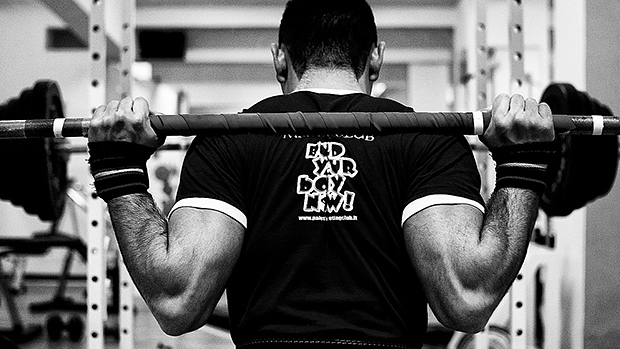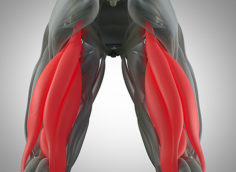The Basics of Back Cycling
Back cycling is purposefully overtraining yourself for a short period of time, then pulling back to allow your body to super-compensate with muscular growth. It's not the same as "muscle confusion," which is simply a haphazard changing of routines without rhyme or reason. Instead, back cycling is like "controlled overtraining" that consists of both a density and de-loading phase.
In the density phase, you increase the density of training for two to three weeks and do more work per unit of time. This means increased sets, reps, and exercises per workout, but keeping the workout length the same. To pack in more stuff within this brief timeframe, you must employ shorter rest periods and use set extenders. Think of it as putting your body into overdrive.
You can't stay in overdrive forever, though. You have to pull back or "back cycle." In this phase, rather than focus on training density, you lower the volume and focus on training intensity. This means heavier weight, lower reps, longer rest periods, and fewer sets and exercises.
There are many ways to use back cycling, but I've found the following three strategies most effective:
- Cutting back on training volume
- Decompression of training frequency
- Abbreviation of your exercise routine
In this method of back cycling, you train with a high number of sets and reps for two to three weeks and then cut the volume down by at least 40 percent for the next two to three weeks.
An easy way to figure out how to use this method is to add up all the reps for each body part in a workout. If the rep totals are high, then switch to lower rep totals in your next program. If your totals are low, then switch to a program with a higher rep total.
For instance:
| Weeks | Sets | Reps | Rest | Total Volume |
|---|---|---|---|---|
| 1, 2 | 10 | 10 | 1:00 | 100 |
| 3, 4 | 6 | 6 | 2:00 | 36 |
| 5, 6 | 8 | 8 | 0:30 | 64 |
| 7, 8 | 5 | 5 | 3:00 | 25 |
| 9, 10 | 4 | 12 | 1:30 | 48 |
| 11, 12 | 8 | 3 | 1:00 | 24 |
The sets and reps are for each body part that you wish to train. In order words, 10x10 means 10 sets of 10 reps for the chest, 10 sets of 10 reps for the back, and so on.
Stay with each set and rep scheme for a couple of weeks and then move on to the next. How you want to split the body parts and what split routine you want to use is up to you, just be careful not to go beyond 20 sets per workout.
With this method, you'll want to train at a very high frequency for one to two weeks and then train at a low frequency for two to three weeks. This works well for body part specializations and bringing up lagging muscle groups.
So let's say you've got a decent amount of muscle everywhere except for your calves. Immediately below is the split I'd use, followed by descriptions of the example program:
| Week 1 | Week 2 | Week 3 | Week 4 | |
|---|---|---|---|---|
| Saturday | Workout A | Workout A | Workout C | Workout C |
| Sunday | Workout B | Workout B | Off | Off |
| Monday | Workout A | Workout A | Workout C | Workout C |
| Tuesday | Workout B | Workout B | Off | Off |
| Wednesday | Workout A | Workout A | Workout C | Workout C |
| Thursday | Workout B | Workout B | Off | Off |
| Friday | Off | Off | Off | Off |
Weeks 1, 2

Alternate between Workouts A and B six days a week.
Workout A
Standing One-Legged Calf Raises (bodyweight only): You'll perform bodyweight-only one-legged calf raises off the edge of a calf block. One hand will be holding on to a stable support. Alternate between the left and right leg with little or no rest until you reach 100 reps on each calf. Start off with a high number of reps at first. When your reps start falling below 10, rest for about 30 seconds and resume.
Maintenance mode for all other body parts: 3 sets of 6-8 reps.
Workout B
- Standing Machine Calf Raises 5 sets of 10-12 reps
- Leg Press Calf Raises 3 sets of 20 reps
- Seated Calf Raises 2 sets of 25 reps
Week 3-5
Follow this workout three days a week, every other day:
Workout C
- Dumbbell Calf Raises 5 sets of 10-12 reps
- Seated Calf Raises 3 sets of 20 reps
Maintenance mode for all other body parts: 3 sets of 6-8 reps
Here's a situation that plays itself out often in the gym: a frustrated skinny bastard follows a routine found in a muscle mag. The routine includes multiple exercises for each body part, as well as the kitchen sink. The skinny bastard follows the routine for a while and makes some initial progress, but then he plateaus and eventually burns out from the sheer volume of 3-5 exercises for every body part.
A strength enthusiast tells our skinny bastard to cut out the isolation exercises and machines and stick to heavy weight on basic compound movements and–voila!–muscle growth.
Switching from multi-angular training to an abbreviated strength program is a form of back cycling. From a bodybuilding perspective, you must train a muscle group from more than one angle in order to fully maximize its development.
Yet from a strength perspective, there's little benefit to performing more than one exercise per muscle group since every exercise after the first will yield diminishing returns because you'll be tired as hell.
Alternating phases of bodybuilding-based training and powerlifting-based training allows you to develop both muscle symmetry and muscle mass. Here's a two-phased program that alternates typical bodybuilding-style training with an abbreviated strength program:
Weeks 1, 2
Rotate through the following three workouts. Train three days in a row then take one day off. Repeat.
Workout A
- Chest
- Bench Press 5 sets, 8-10 reps
- Incline Dumbbell Press 5 sets, 8-10 reps
- Pec Deck Fly 4 sets, 10-12 reps
- Back
- Lat Pull-down 5 sets, 10-12 reps
- Dumbbell Row 4 sets, 8-10 reps
- Seated Cable Row 4 sets, 8-10 reps
Workout B
- Thighs
- Barbell Back Squat 4 sets, 10-12 reps
- Leg Press 4 sets, 10-12 reps
- Leg Extension 4 sets, 10-12 reps
- Leg Curl 4 sets, 10-12 reps
- Calves
- Standing Calf Raise 4 sets, 15-20 reps
- Donkey Calf Raise 4 sets, 15-20 reps
- Seated Calf Raises 4 sets, 15-20 reps
Workout C
- Shoulders
- Military Press 5 sets, 8-10 reps
- Lateral Raise 5 sets, 10-12 reps
- Bent-over Lateral Raise 4 sets, 10-12 reps
- Biceps
- Barbell Curl 4 sets, 8-10 reps
- Incline Dumbbell Curl 4 sets, 10-12 reps
- Preacher Curl 4 sets, 8-10 reps
- Triceps
- Lying Triceps Extension 4 sets, 8-10 reps
- Overhead Cable Triceps Extension 4 sets, 10-12 reps
- Close-grip Bench Press 4 sets, 10-12 reps
Weeks 3-6

Alternate between the following two workouts three days a week, every other day with weekends off:
Workout A
- Bench Press 6-8 sets of 3-6 reps, 3-minute rest periods
- Deadlift 6-8 sets of 3-6 reps, 3-minute rest periods
Workout B
- Pull-up 6 sets of as many reps as possible, 3-minute rest periods
- Back Squat 6-8 sets of 3-6 reps, 3-minute rest periods
We know growth comes with change, but most guys are confused about how and when to change their routine. Leave "muscle confusion" to the confused guys and use strategic back cycling to push through plateaus and gain new muscle.





